Posts Tagged by lauren brady
When the United States entered World War II, there were immediate voids in the workforce left by those leaving to fight abroad. Women across the country heard a call to action and stepped in, taking on new roles previously held only by men.
Popularized by the song Rosie the Riveter, Rosie became the fictional face of these early wartime women workers. Rosie was feminine, yet strong and powerful, changing the societal stigmas against working women and drawing interest in wartime work.
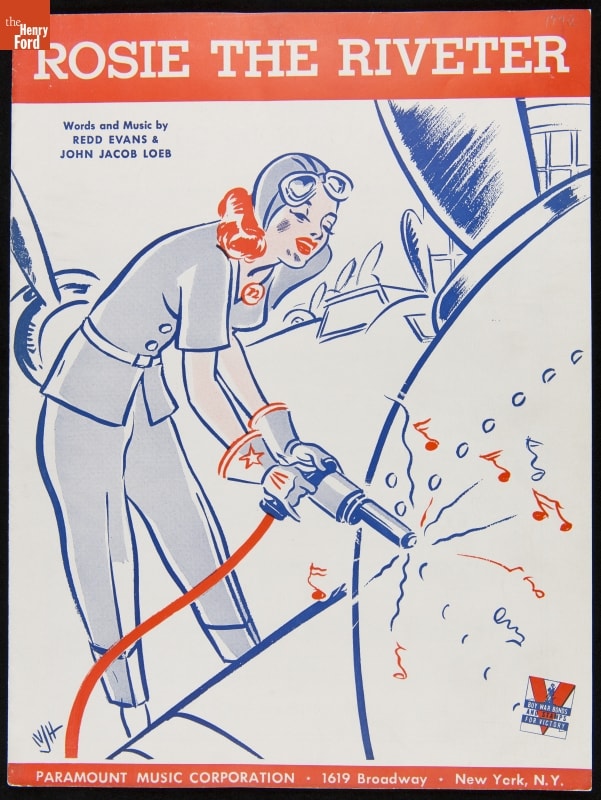
"Rosie the Riveter" sheet music, 1942. / THF290068
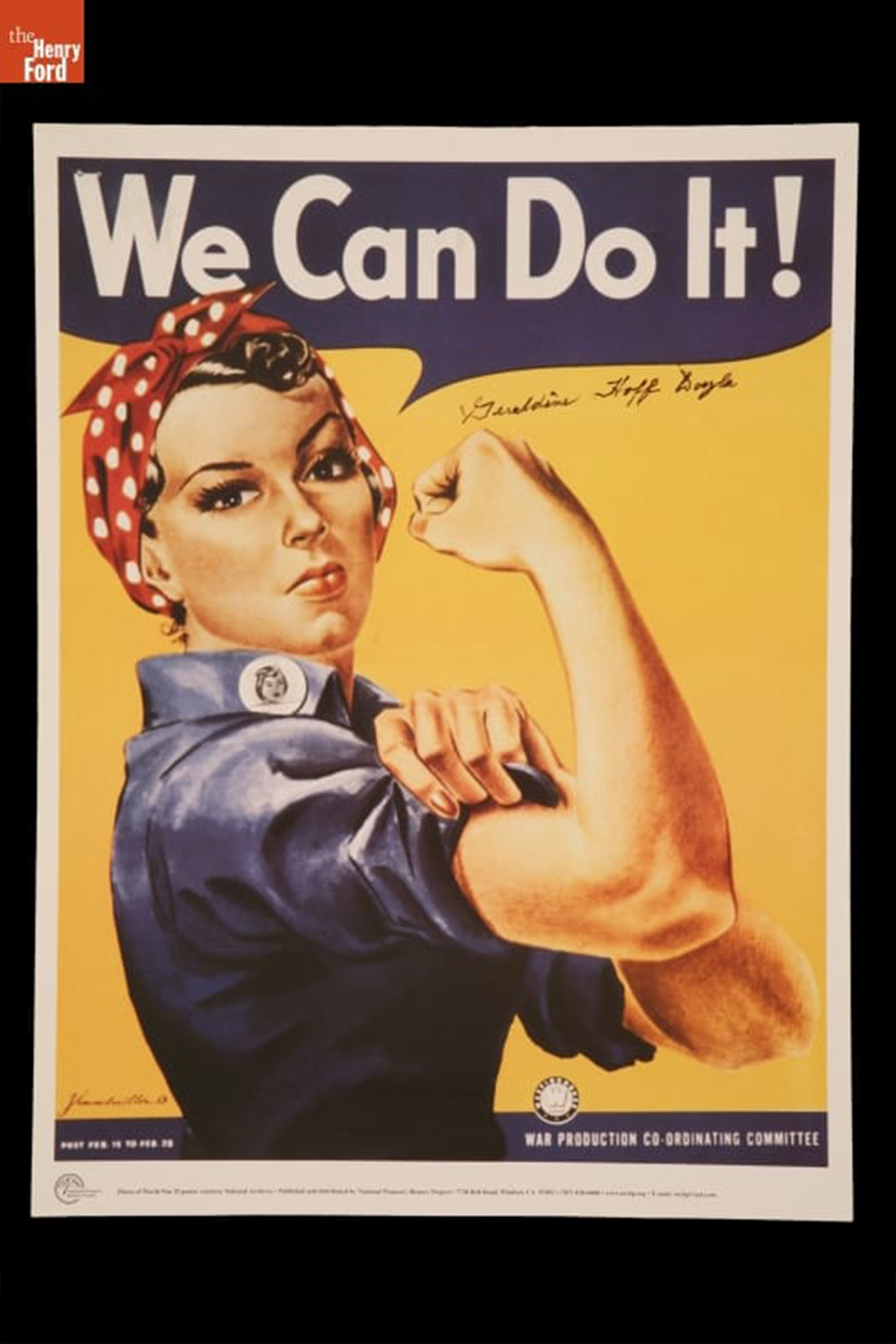
Reproduction World War II Poster, "We Can Do It!," 1998. / THF108519
Women across the country were inspired to join the ranks of Rosie but concerns over gender roles and domestic responsibilities discouraged others. However, as the war raged on and production needs continued to rise, the United States was faced with a manpower, or rather a womanpower, crisis.
Late in 1942, the War Manpower Commission announced a new campaign to recruit more women workers after estimating the majority of roughly five million new employees in 1943 would have to be women to keep up with war production demands. Ford Motor Company, placed at the center of the arsenal of democracy, was a leader in this campaign and shaping their facilities to attract more women to factory work.
Stories of real-life Rosies proved helpful in motivating others to find their place in Ford factories. These stories, documented by the Ford Motor Company Photographic Department, were distributed across the country to news publications large and small.
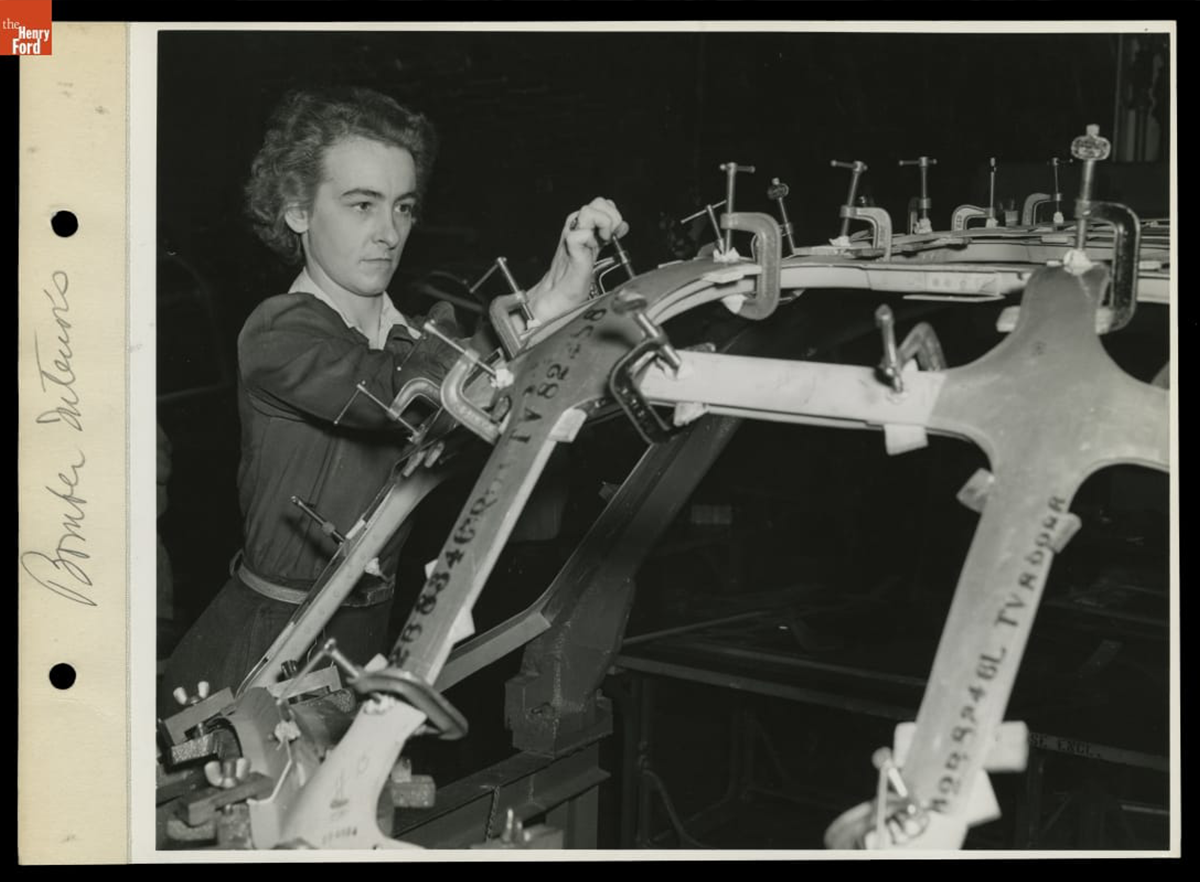
Riveter Florence Nightingale Working at Willow Run Bomber Plant, 1942. / THF93712
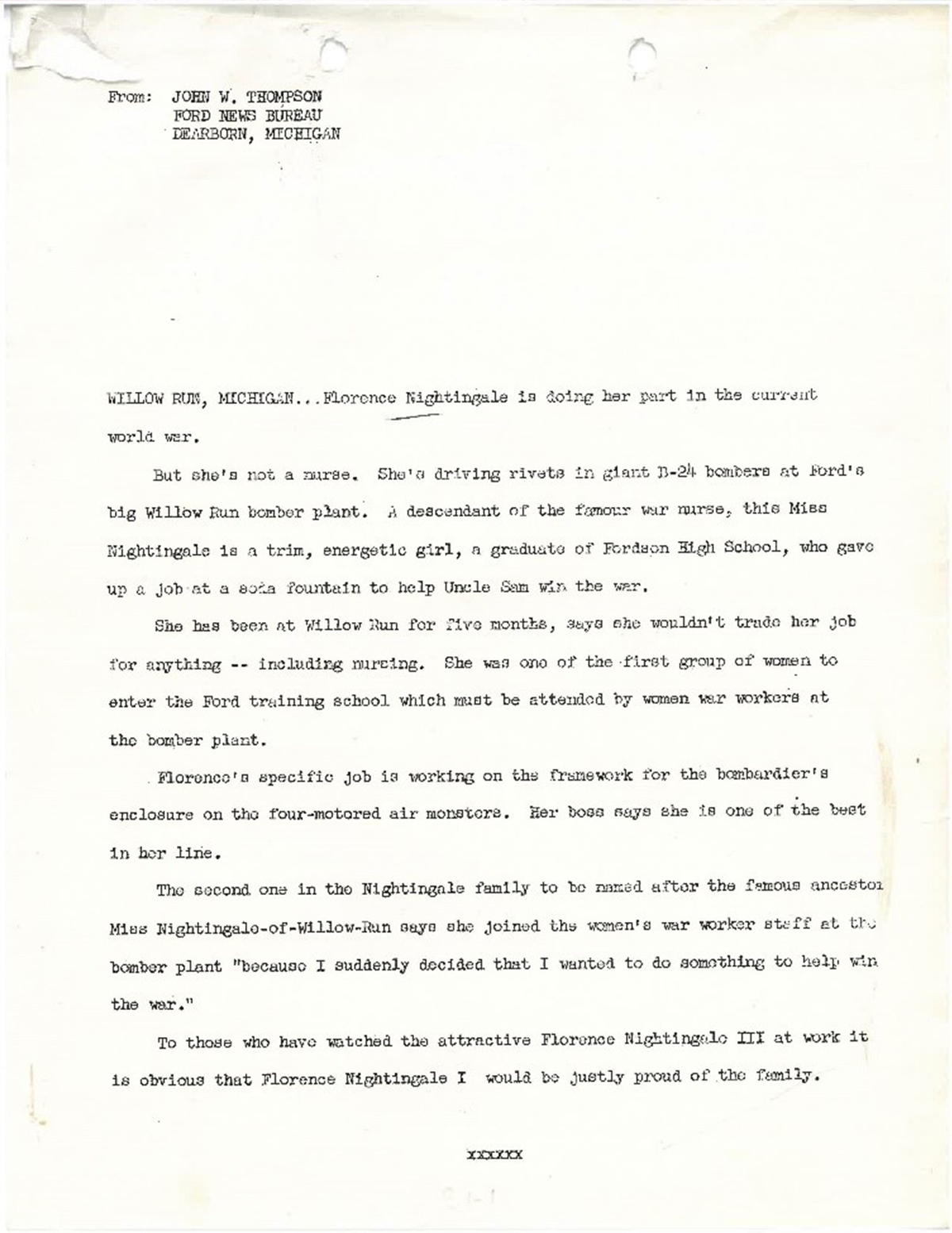
Florence Nightingale III Press Release, 1942. Accession 378, Box 30.
The story of Florence Nightingale III, descendant of the famous war nurse, was distributed locally and meant to recall the long-standing tradition of women’s contributions during wartime.
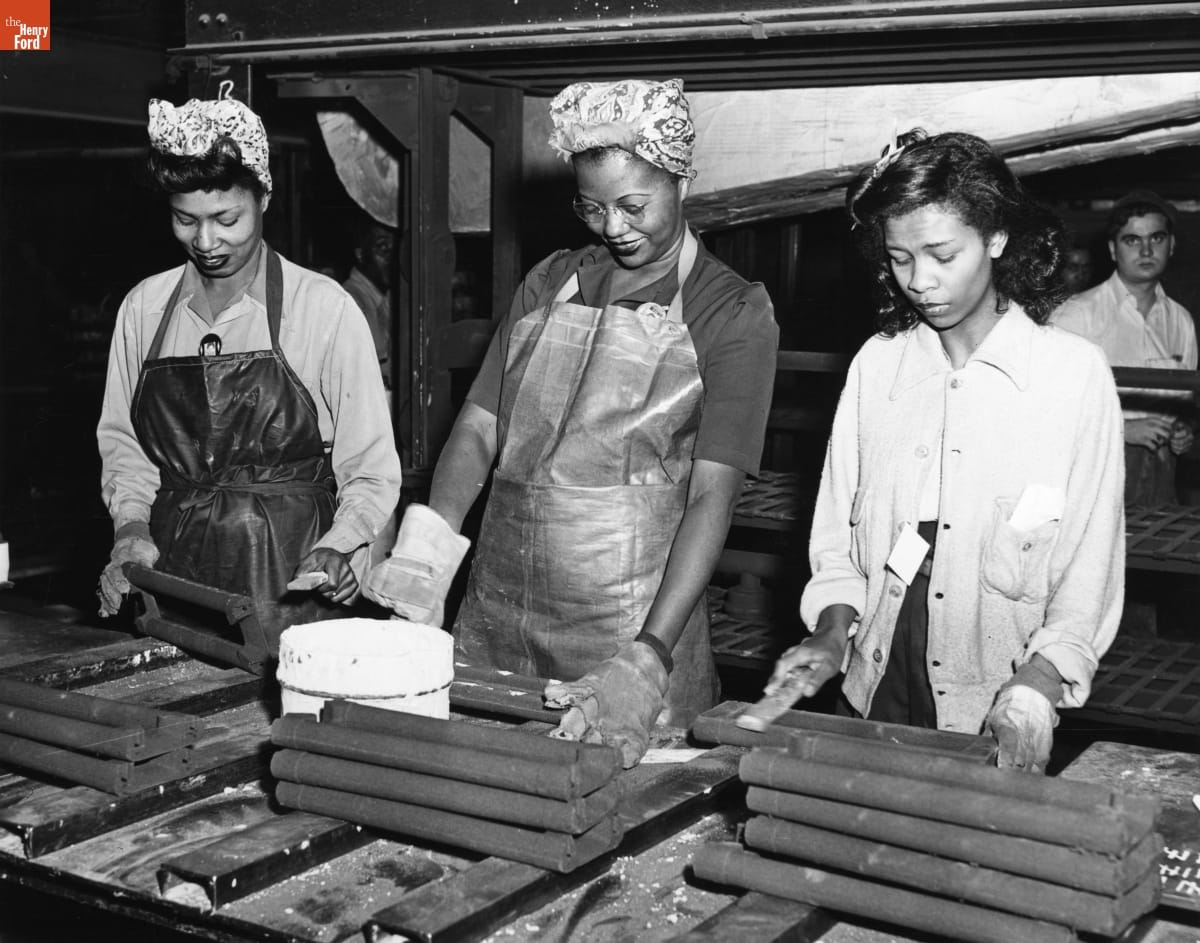
Women Making Sandcore Molds for Casting Cylinder Heads for Airplane Engines at the Ford Motor Company Rouge Plant, March 29, 1943. / THF82800
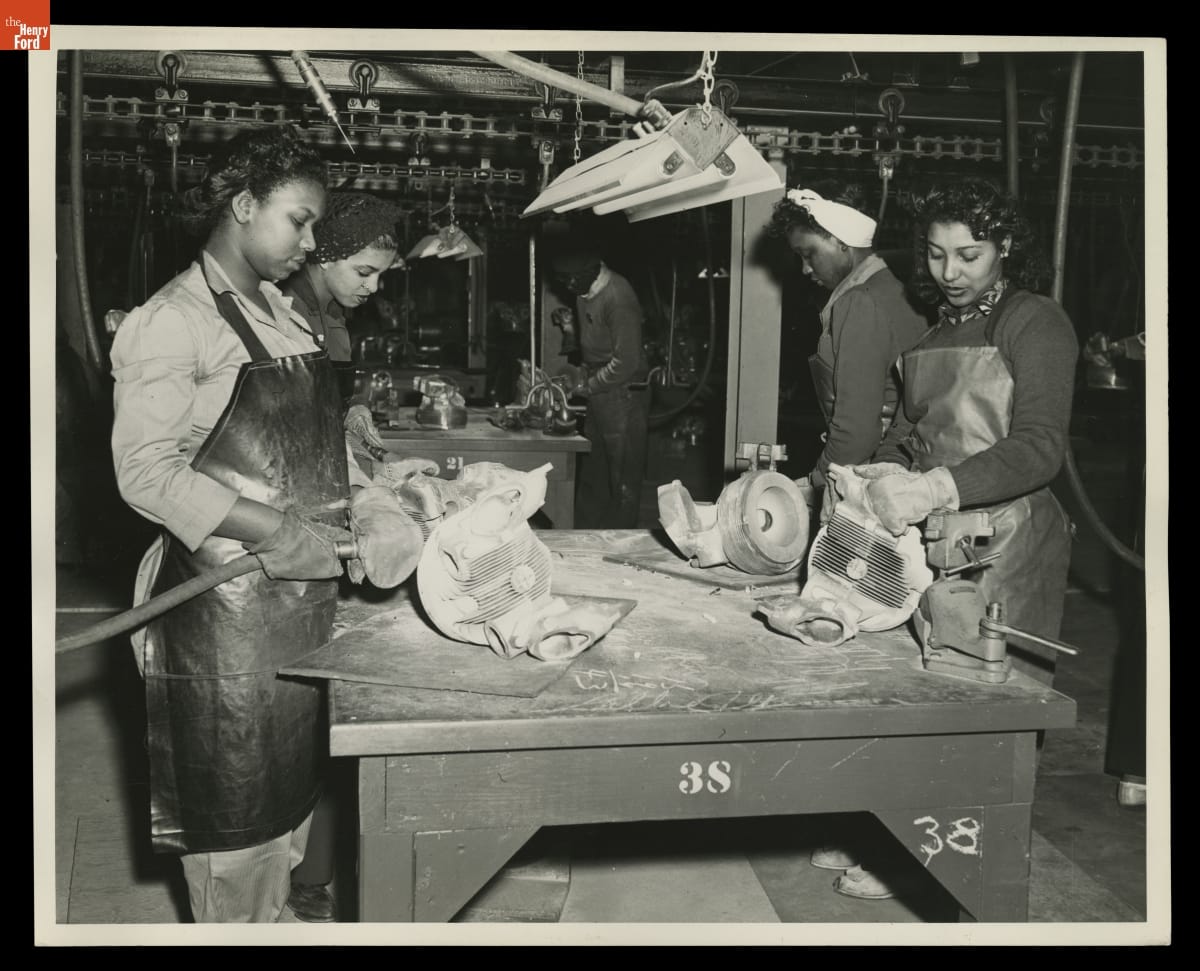
Women Making Sandcore Molds for Casting Pratt & Whitney Airplane Engine Cylinder Heads, Ford Rouge Plant, March 1943. / THF718497
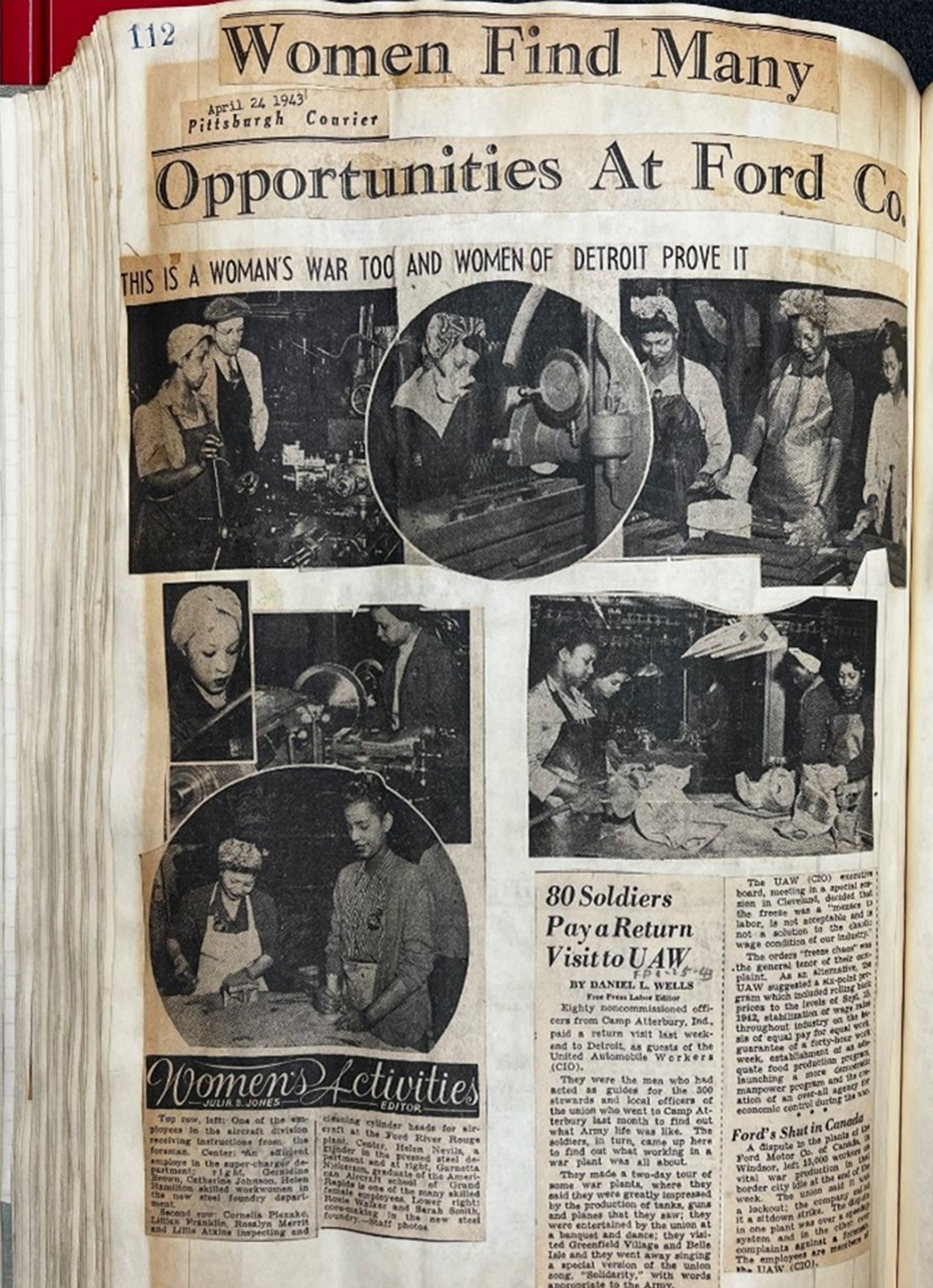
“Women Find Many Opportunities at Ford Co.,” Pittsburgh Courier, April 24, 1943. / Accession 7 Clipping Books Series, 1943.
A story on the women working at Ford Motor Company’s Rouge Plant was shared in the Pittsburgh Courier, highlighting the variety of jobs available to women and praising their skilled contributions to the war effort. Stories like this sought to encourage women to find work at Ford Motor Company and inspire efforts locally.
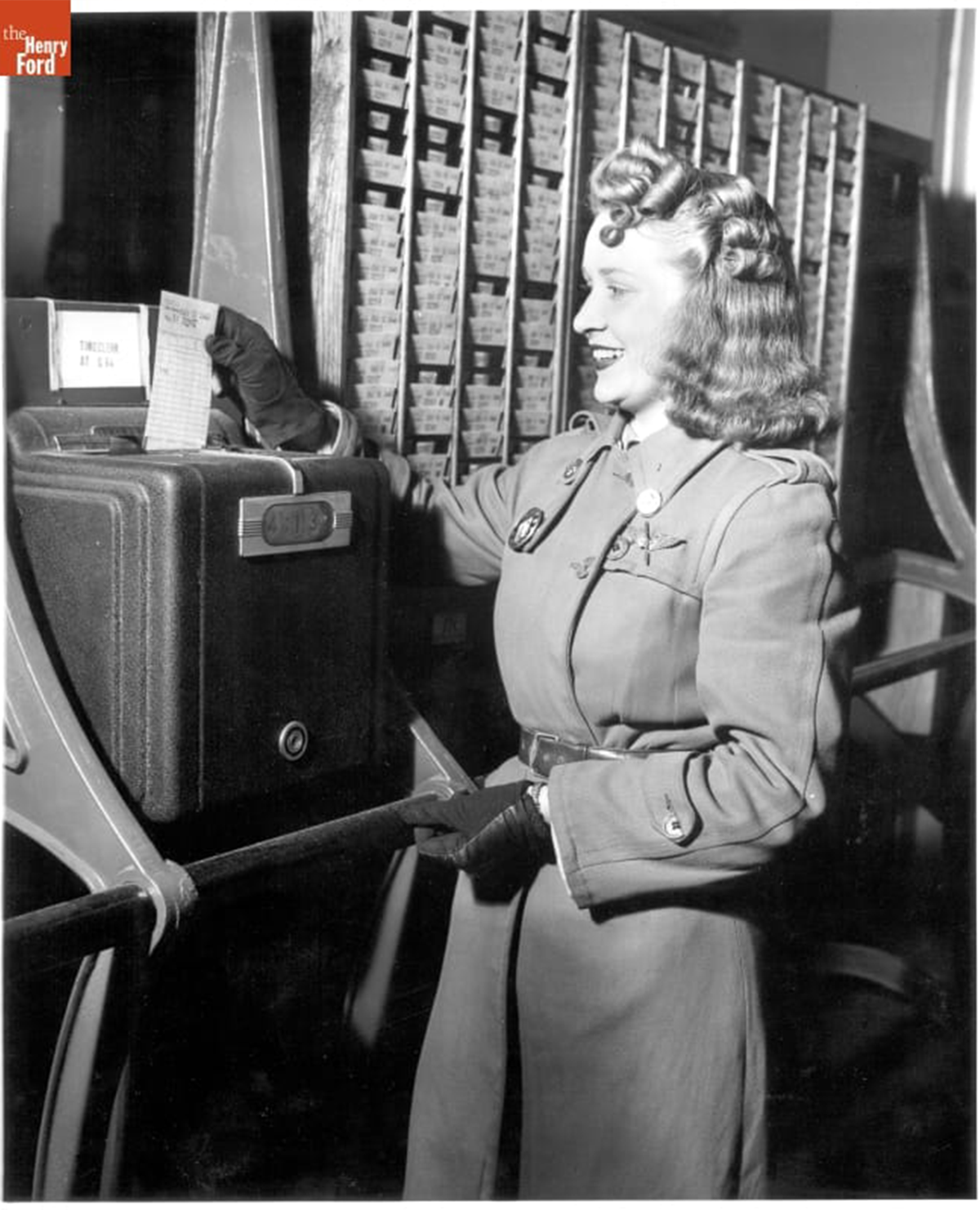
Norma Denton Using the Time Clock at Willow Run Bomber Plant, 1943. / THF23643

Norma Denton Atop an Airplane Assembly, February 1943. / THF326852
Norma Denton, a recent graduate, was featured in LOOK magazine, a popular and nationally distributed publication. Through a photo diary of her workday, part of a series titled Around the Clock Activities, Norma was photographed working, socializing, and enjoying the amenities of Ford Motor Company’s Willow Run plant. Her story aided in making wartime work more approachable and appealing to younger women.
While these special features brought some success, workforce demands persisted and required other innovative ways to draw the number of women workers needed to win the war. Following a visit to Ford’s facilities — likely related to research for his own wartime films — Walt Disney offered some creative suggestions to aid recruitment.
On February 18, 1943, Walt Disney wrote to John W. Thompson, Director of the Ford News Bureau, regarding an idea for a “Womanpower” movie. In his letter, Disney proposed a potential film aimed at attracting women to the factories by emphasizing women’s past contributions during wartime and highlighting the amenities offered to a modern industrial woman. Disney notes how much he enjoyed his visit to the Ford plant and his informal chat with Edsel Ford.
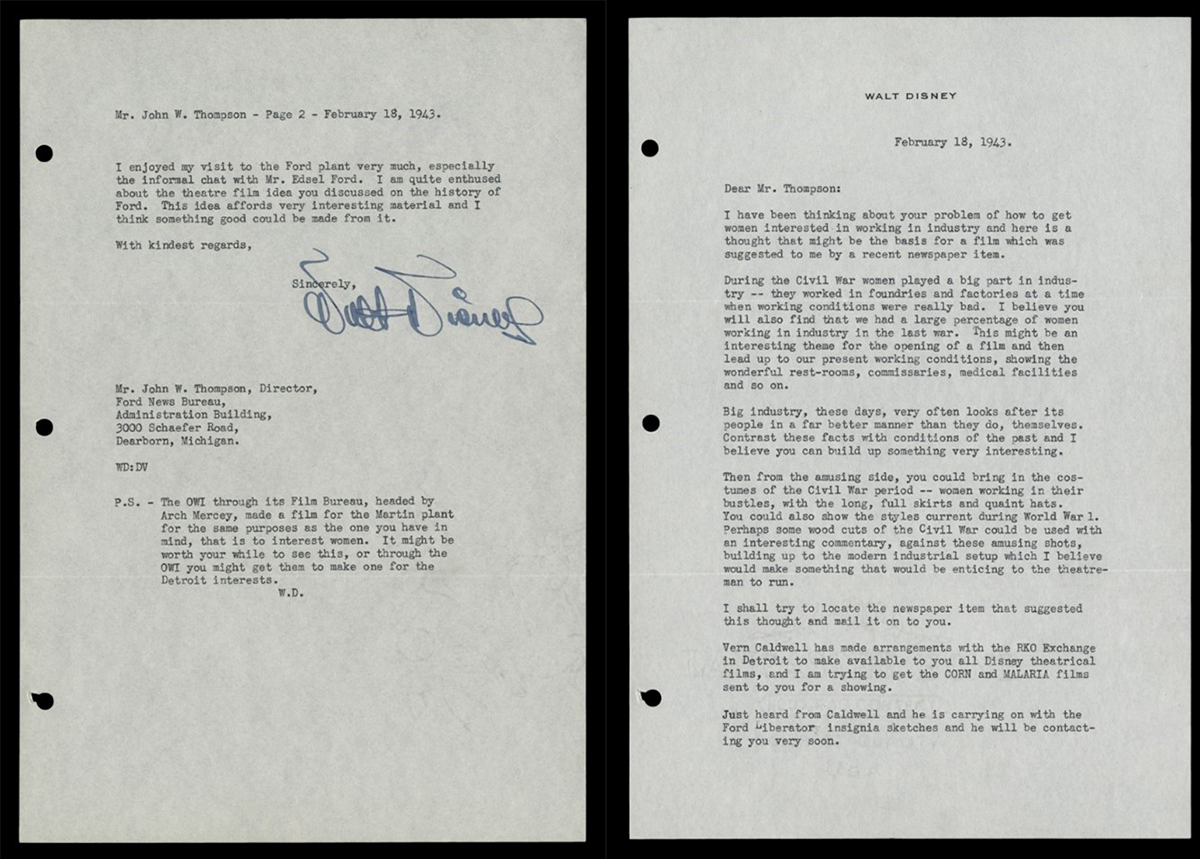
Letter from Walt Disney regarding Making a Ford Motor Company War Work for Women Film, February 18, 1943. / THF131114, THF131115
Edsel seemed to agree with Disney’s suggestion. In a memo from March 1943, he notes that in addition to regular press releases and housing improvements for women employees, a film is in production highlighting women working at Willow Run on aircraft assembly.
The ten-minute film, Women on the Warpath, aimed to inspire the next wave of women workers by recognizing the “American women everywhere, whose valor on the industrial front has sped the day of victory.” Previously, most women workers were young women or those who had traded traditional roles for higher paying factory jobs. The film makes an appeal to all women, including mothers and wives, that they are needed in the factories to help bring victory and their loved one's home. The film was distributed across the country with screenings in theaters and by a variety of women's clubs.
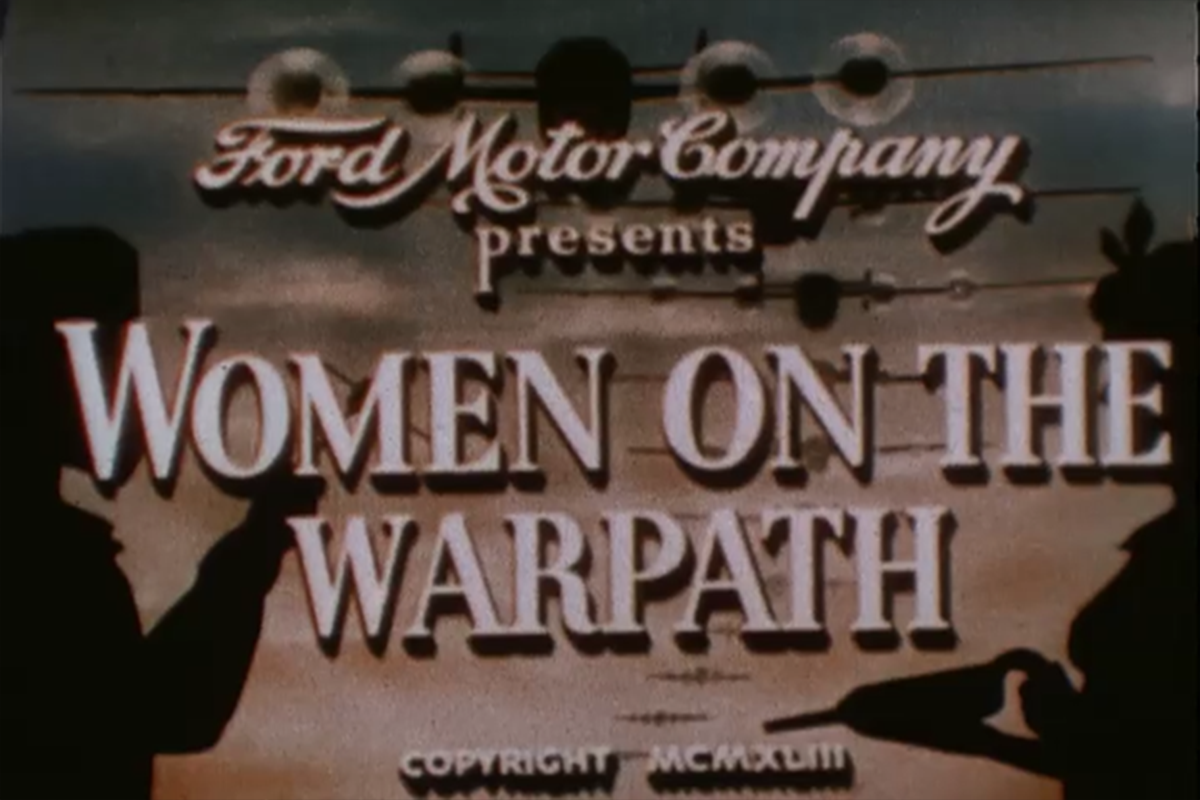
"Women on the Warpath," 1943. / Courtesy of the Ford Motor Company Collection and National Archives at College Park - Motion Pictures.
Ford Motor Company's efforts to recruit women workers proved victorious. During peak production, more than a third of their employees were women. As the war ended and men returned home to their jobs, many women returned to domestic roles seeing their work as a temporary patriotic contribution to help win the war. Others felt liberated from societal expectations and found a new sense of personal and economic freedom through working. It would take time before women represented a significant portion of the workforce in the same way, but the foundation had been laid for a more empowered and promising future.
Lauren Brady is Reference Archivist at The Henry Ford
Clara Ford’s Travel Diaries
When traveling today, it is easy to document our journey through swift clicks of our phones and cameras. The people, sights, and sounds of a moment are captured and recorded through photos, videos, and social media posts making it easy to reflect on where we were and what we enjoyed.
The desire to document a memorable trip has remained a common tradition and in the age of Clara Ford, was accomplished through travel journals or diaries. Even with the advent of photography, film had to be thoughtfully allocated to document the most meaningful memories from a trip.
The Henry Ford's collections include several travel diaries written by Clara Ford dating from 1912 to 1945. Clara did not keep a diary for every trip she took. As the wife of Henry Ford, her travels were frequent and varied. Most of the diaries document her travels overseas, a momentous journey for anyone at that time, and winter retreats to Richmond Hill, Georgia, and Fort Meyers, Florida.
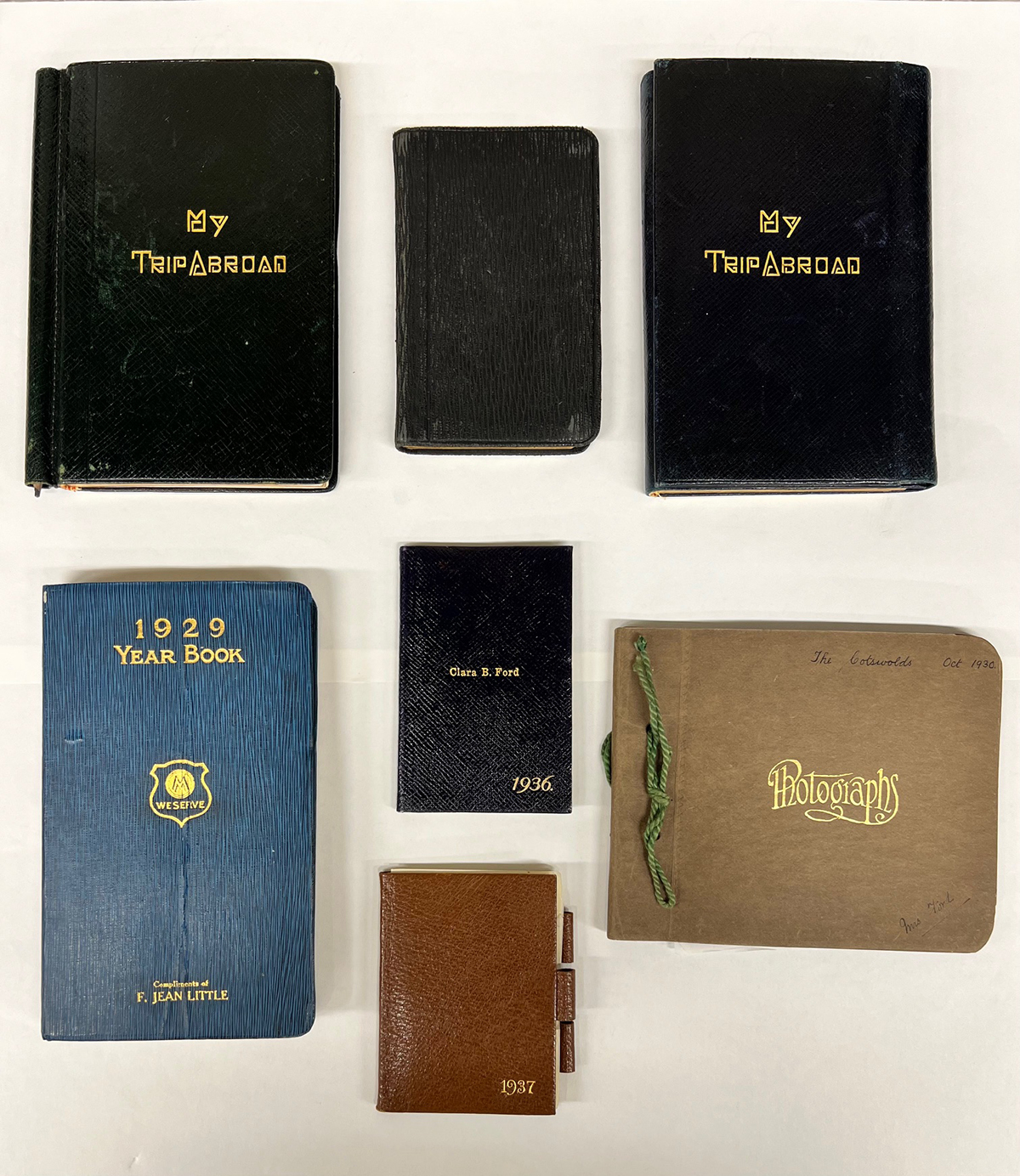
Clara Ford Travel Diaries. Accession 1, Box 105 and 106. / Image by Lauren Brady
Unlike social media posts, travel diaries were not always intended for sharing or future publication. Entries were meant to document travel details and for personal reflection.
This means the writer was often sharing their thoughts more freely. For a notable figure like Clara Ford, travel diaries provide insight into her personal opinions and interests that might have been left out of an official record of her travels. They also provide a valuable record of Clara at a given time and place. They tell us who she interacted with, where she stayed, and what she saw.
The earliest travel diary penned by Clara was for her first trip to Europe in 1912. She, Henry, and Edsel explored sites throughout Great Britain and France.
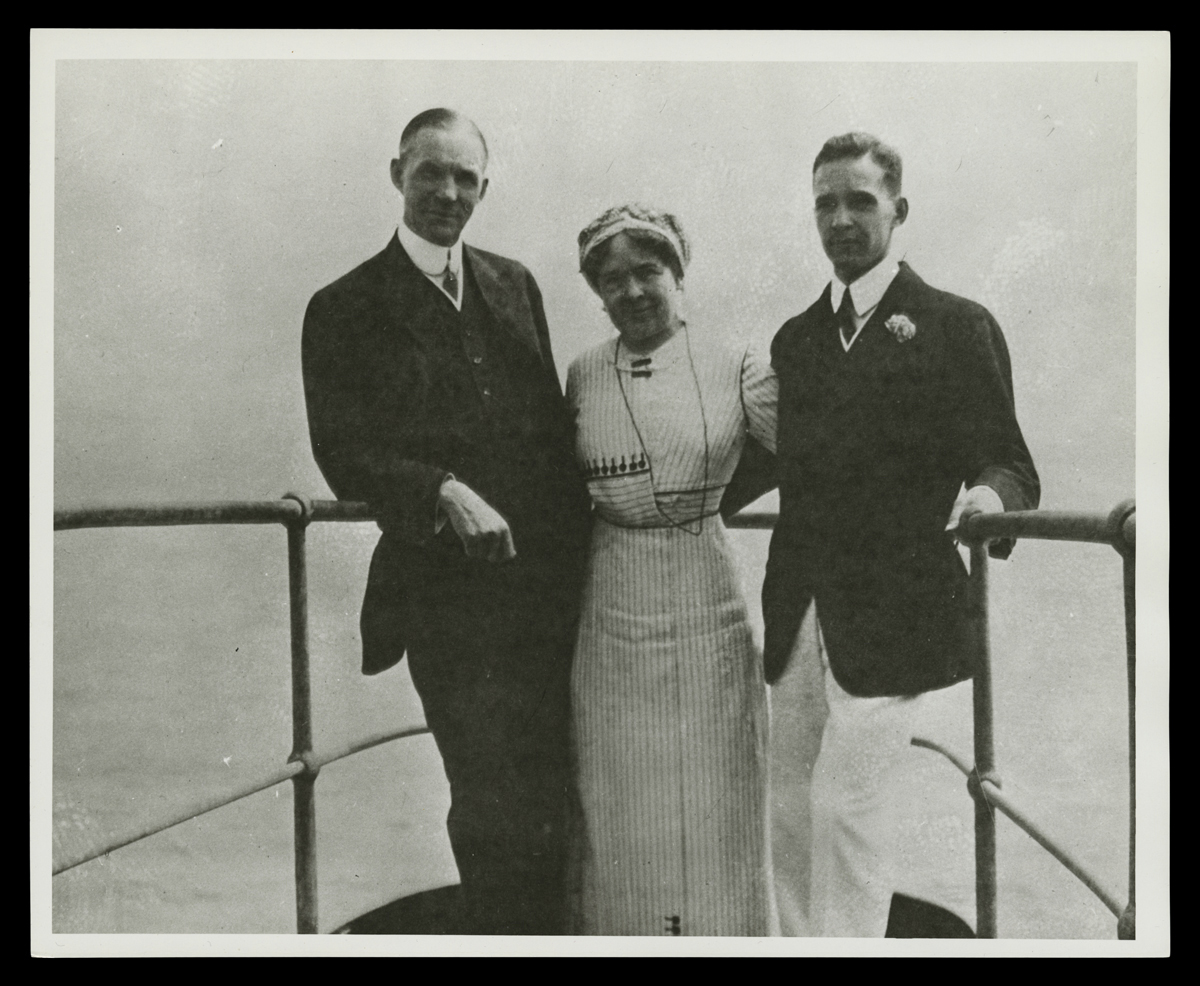
Henry, Clara, and Edsel Ford aboard Ship on their European Trip, 1912. / THF117563
In one of the first entries, Clara documents the time the ship set sail and describes the warm welcome they received. Among flowers, fruits, and candy were several letters from friends wishing them a “Bon Voyage!” Clara references a letter from her close friend, Lulu Wilson, which we also hold in our collection. Connecting archival records like these illustrates a larger picture for historians and researchers.
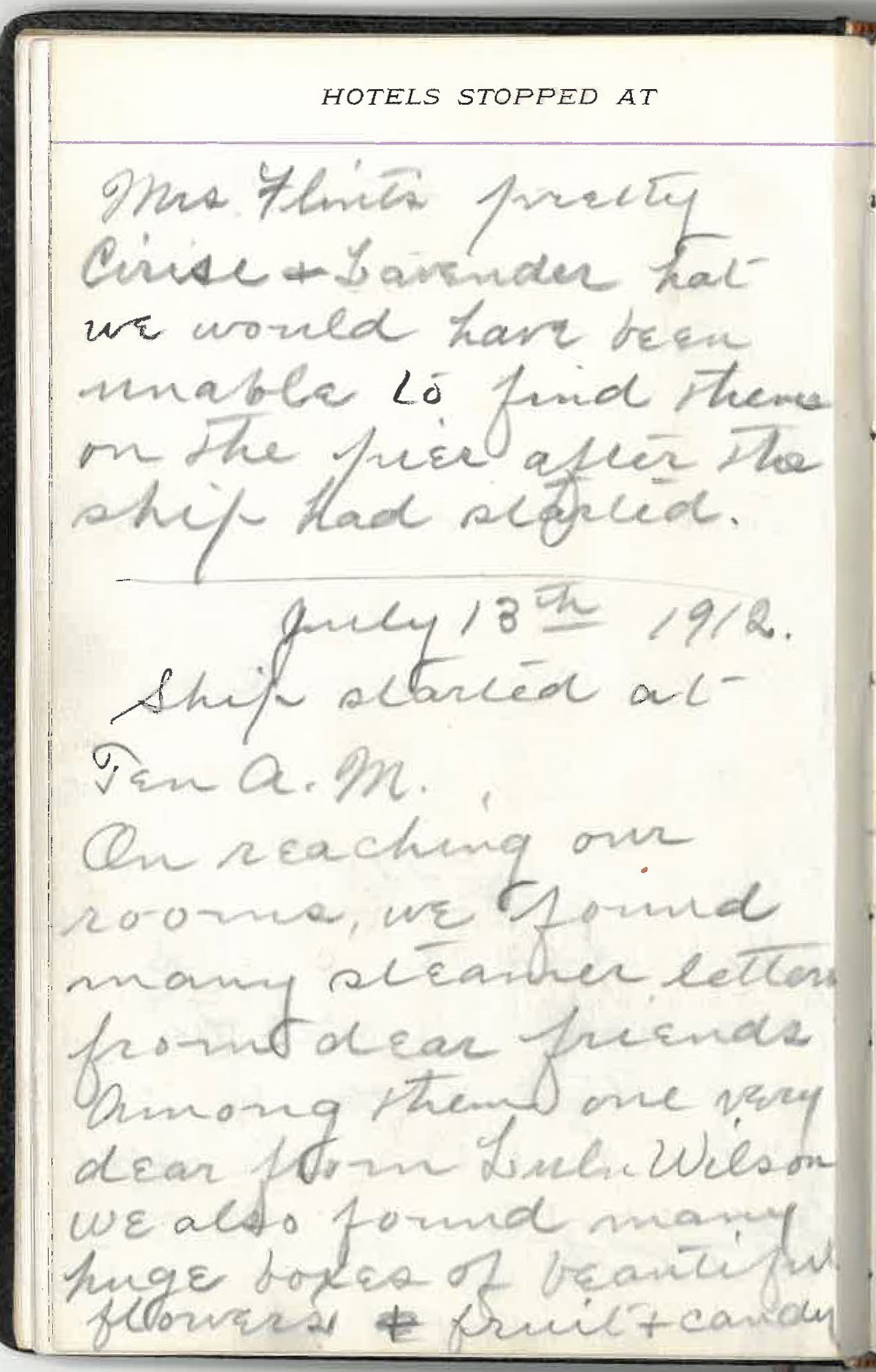
Clara Ford's Travel Diary, 1912. Accession 1, Box 106. / Image by Lauren Brady
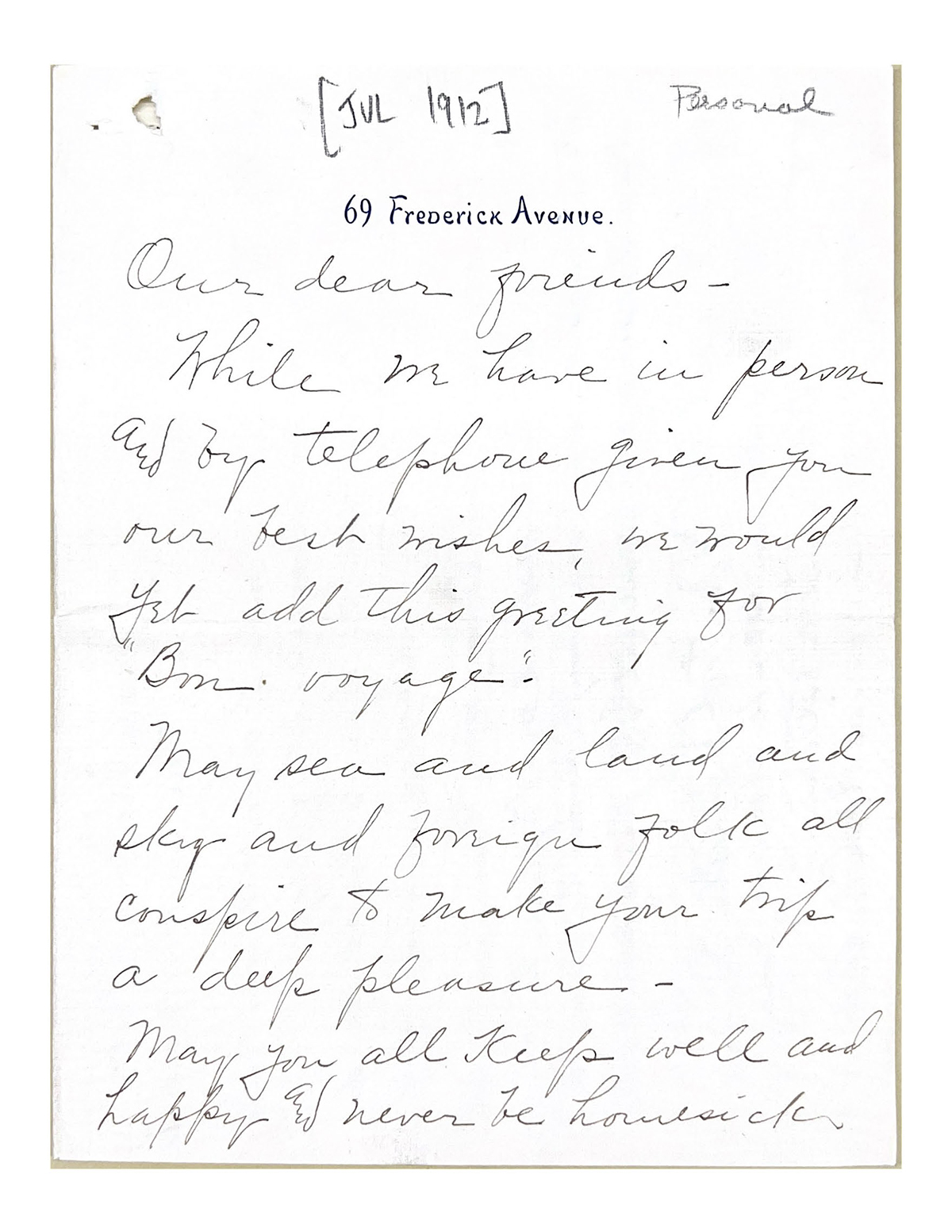
Letter to Clara Ford from her friend Lulu Wilson, July 1912. Accession 1, Box 66. / Image by Lauren Brady
In addition to Clara's diary, we also have Edsel's diary from this trip in our collection.
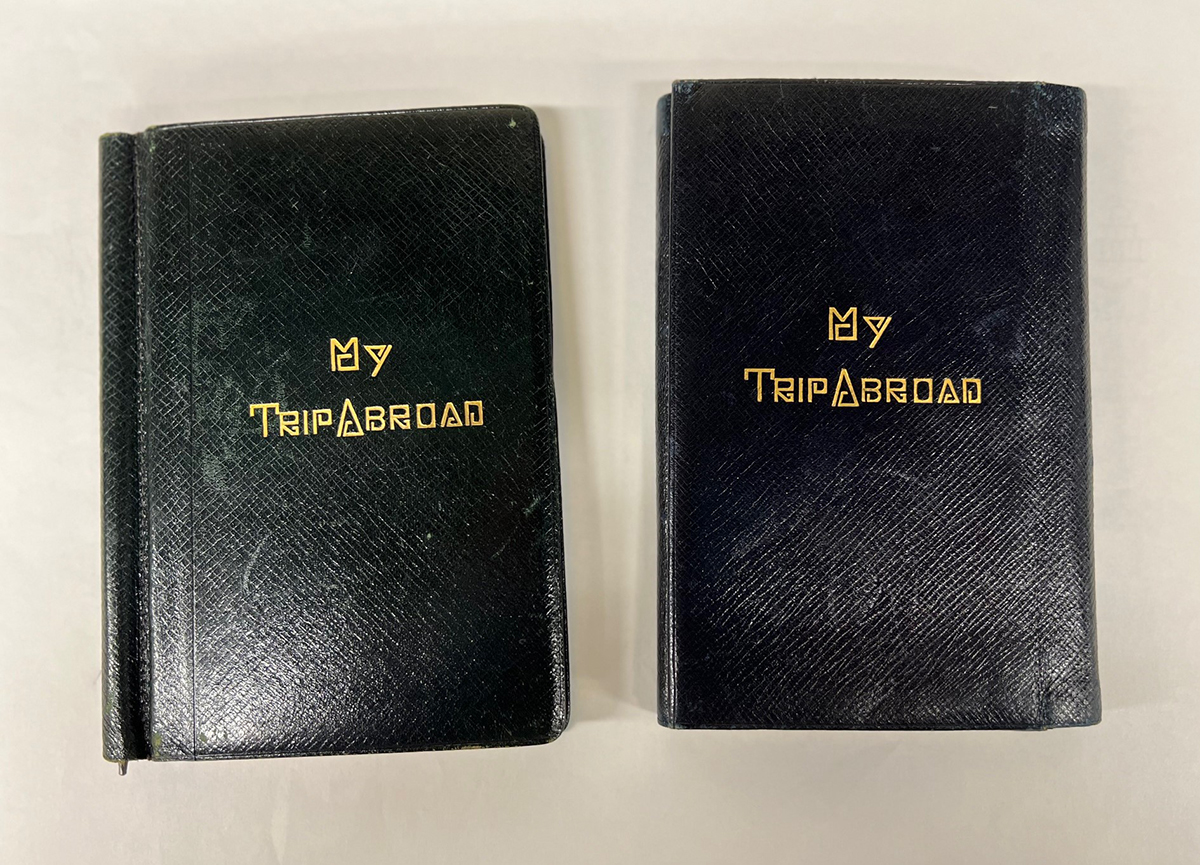
Clara Ford's and Edsel Ford's Travel Diaries, 1912. Accession 1, Box 106. / Image by Lauren Brady
During their travels, they visited Clara's ancestral home. There are parallel accounts of the visit in both diaries. It reads as a meaningful visit for Clara who also describes important genealogical details about her family history that may not have been recorded elsewhere in our archival collections.
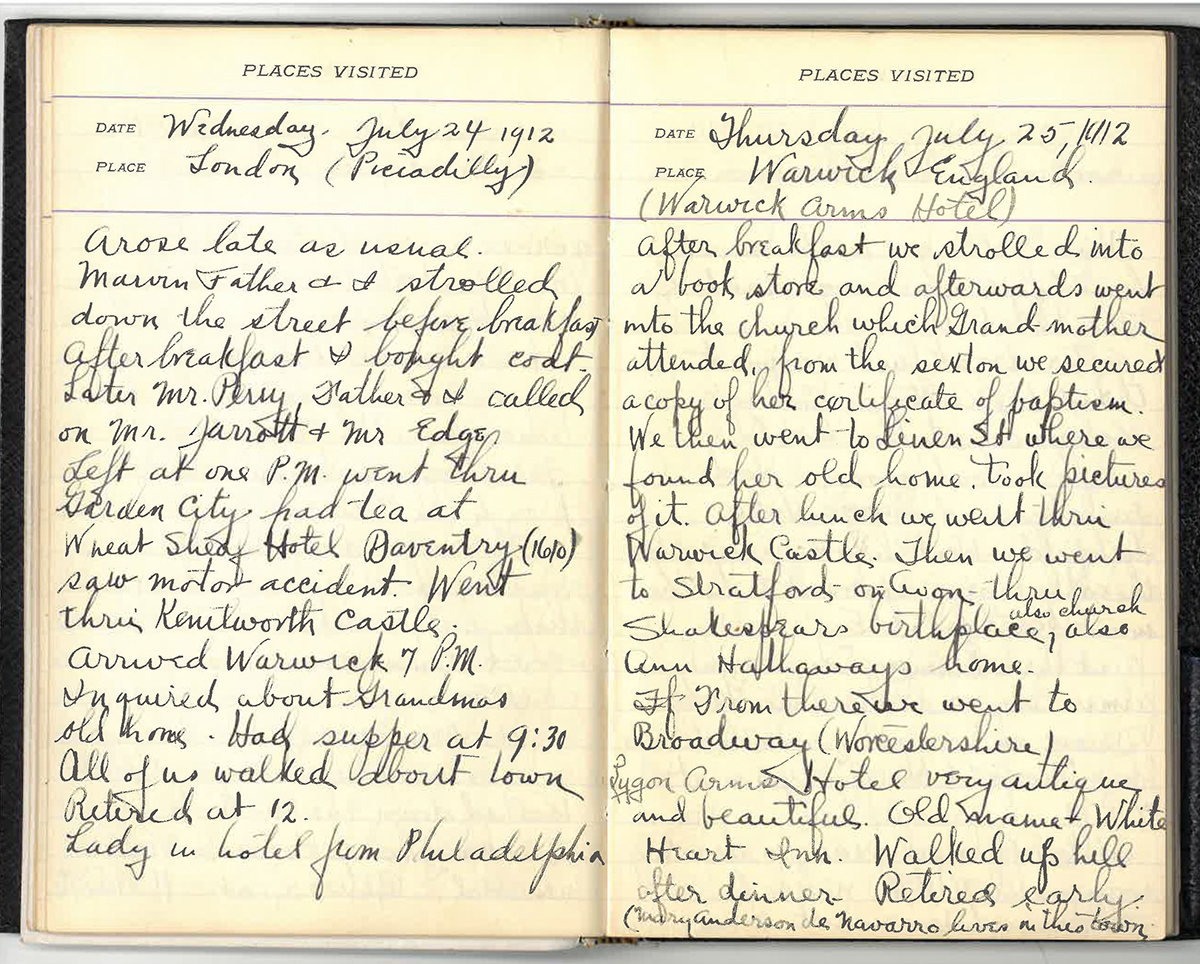
Edsel Ford's Travel Diary, 1912. Accession 1, Box 106. / Image by Lauren Brady
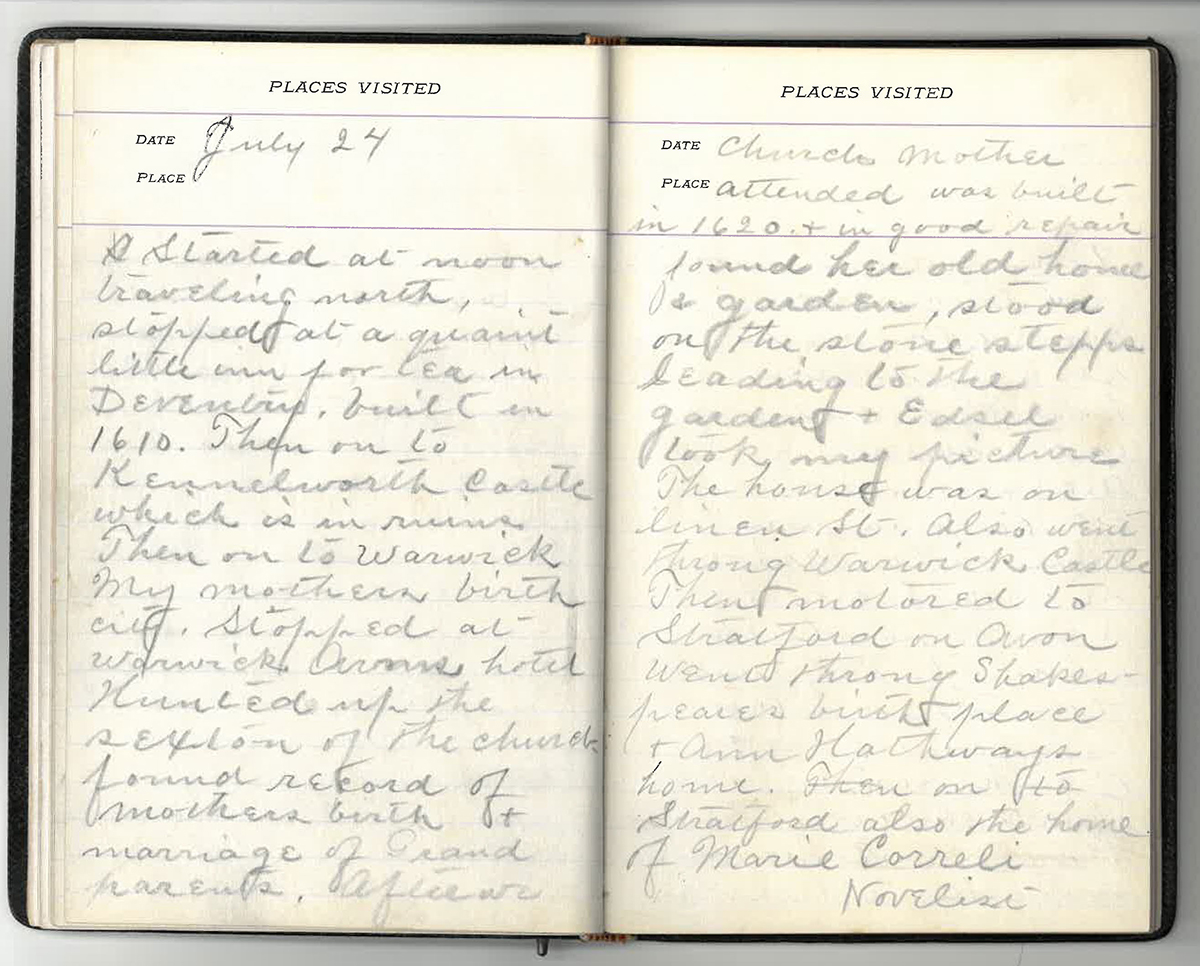
Clara Ford's Travel Diary, 1912. Accession 1, Box 106. / Image by Lauren Brady
The Fords returned to Europe many times, including a trip in 1930 which Clara documented in a diary and a unique photo album. In her diary, Clara makes note of Henry's visit to Buckingham Palace before he departed for the Cotswold region of England where Cotswold Cottage had recently been acquired for Greenfield Village.
This visit received special commemoration in a photo diary with handwritten notes by Clara.
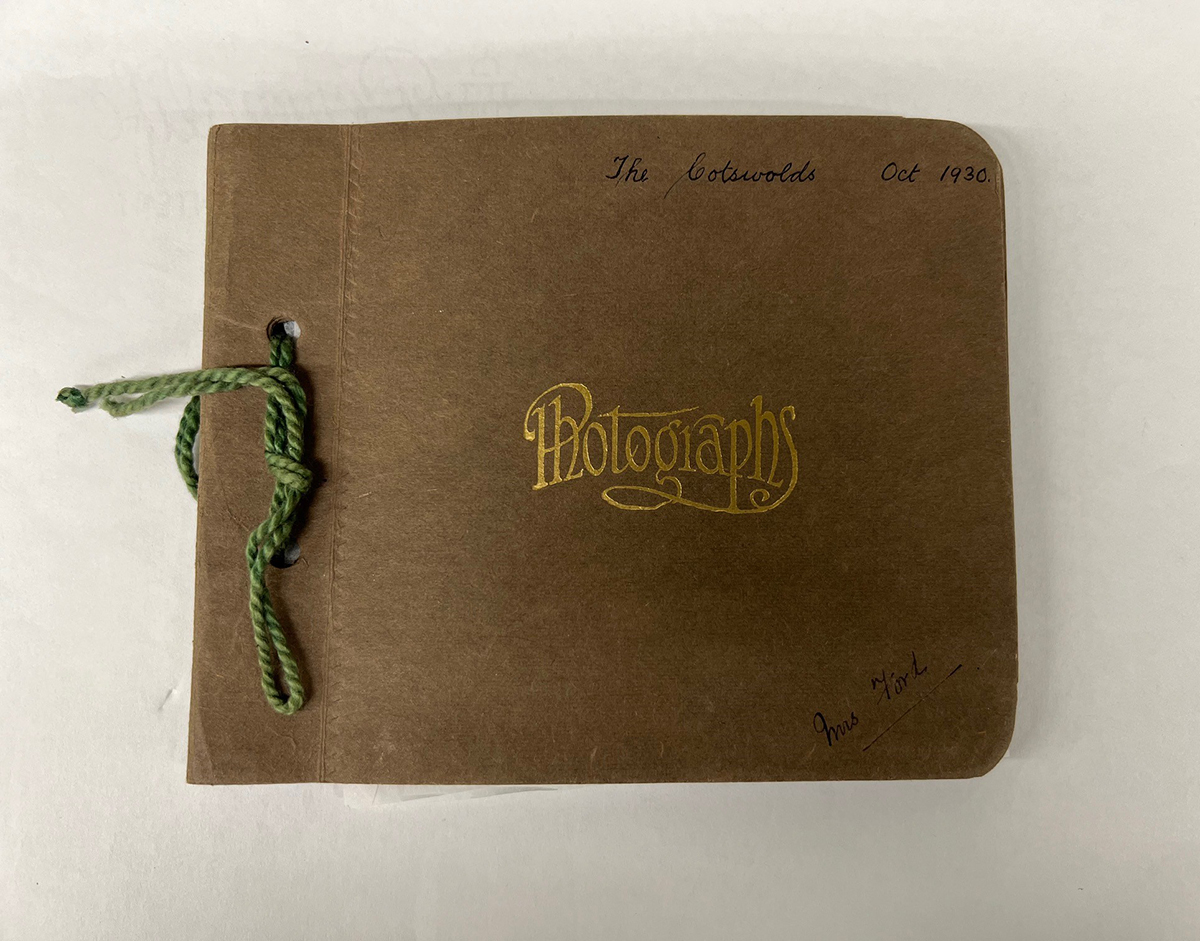
"The Cotswolds" Photograph Album, 1930. Accession 1, Box 106. / Image by Lauren Brady
The album includes several snapshots of their visit culminating with a group photo at the former site of Cotswold Cottage. Clara's notes read like a short story as she describes the photos and recounts details.
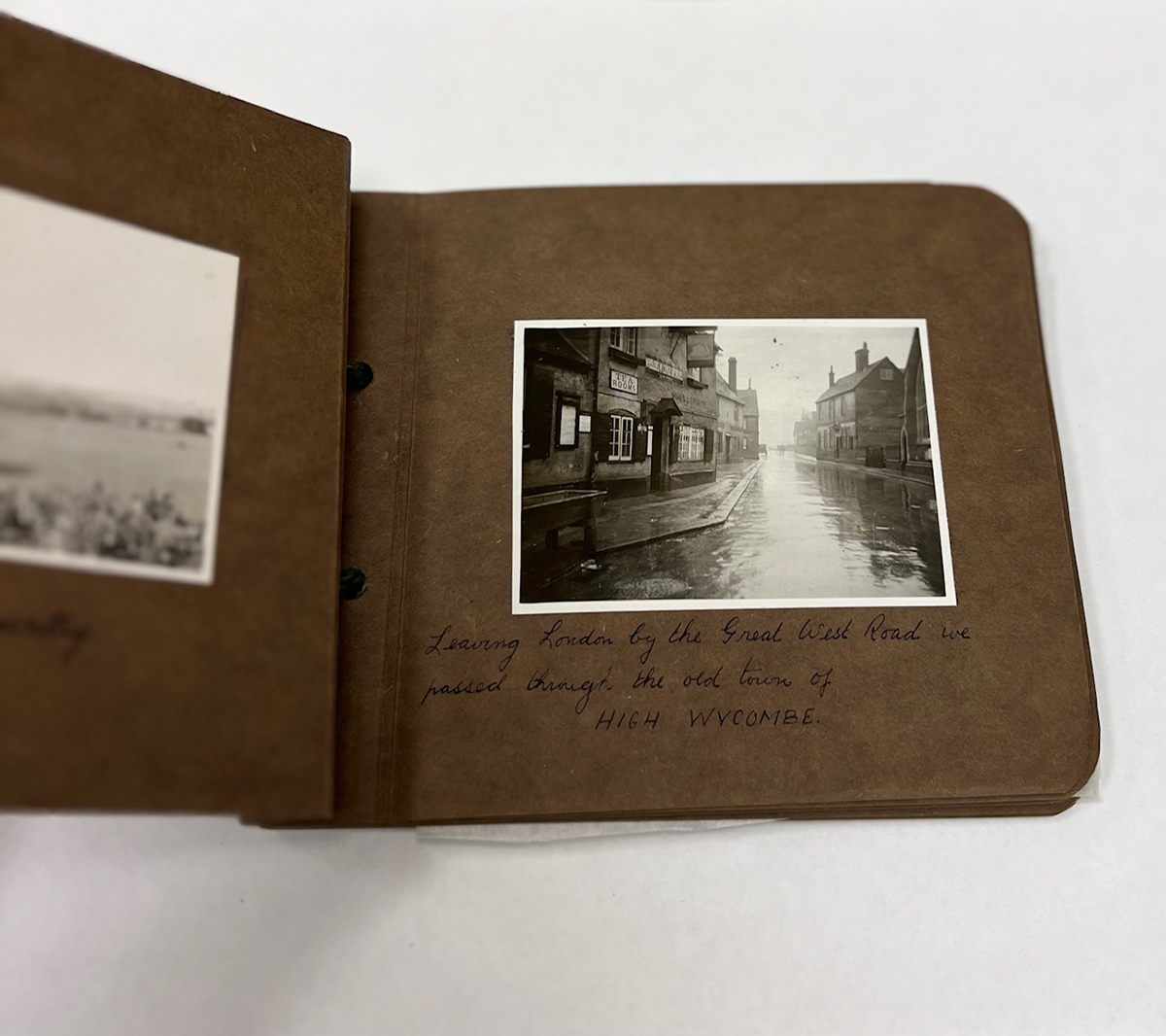
"The Cotswolds" Photograph Album, 1930. Accession 1, Box 106. / Image by Lauren Brady
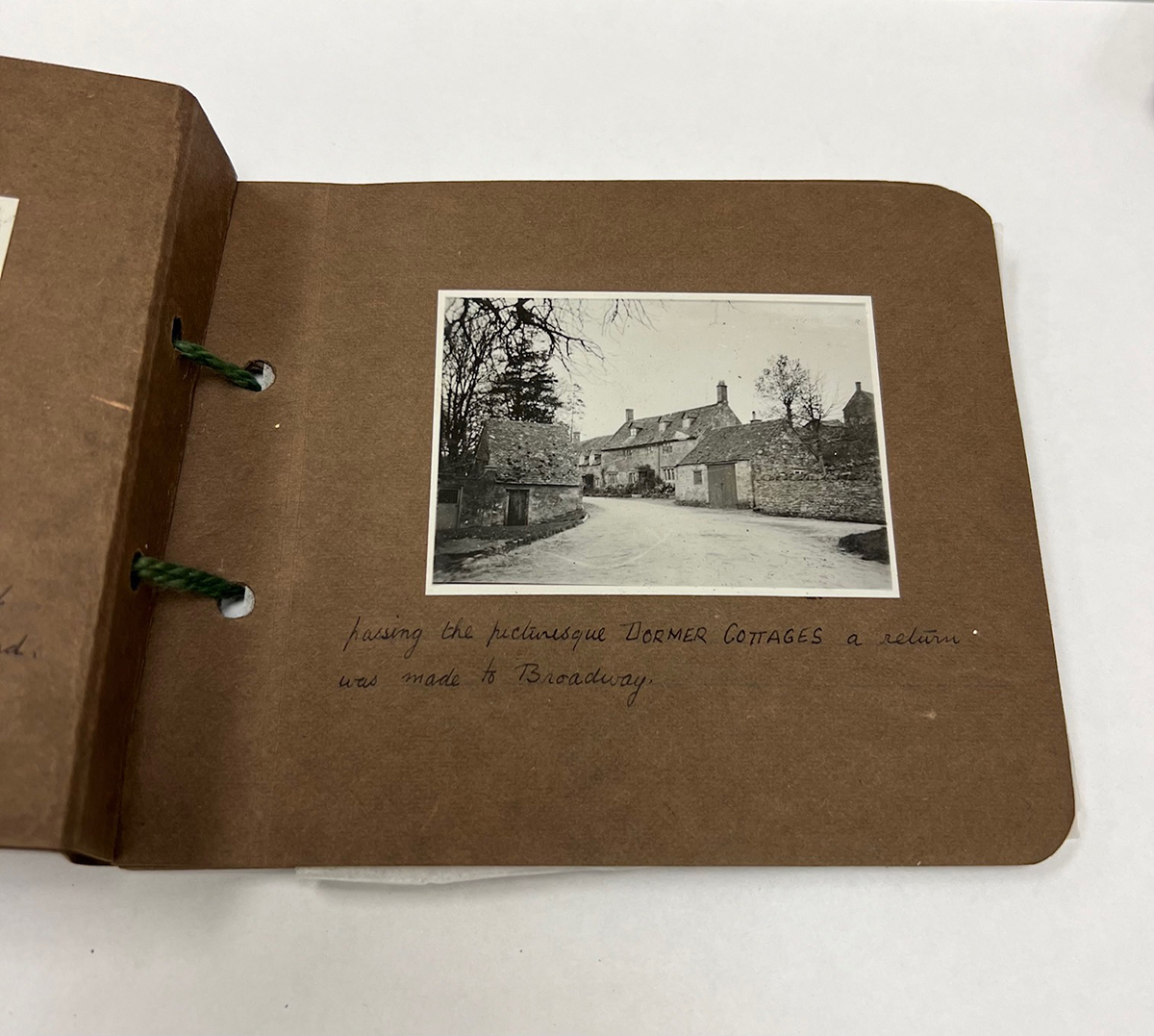
"The Cotswolds" Photograph Album, 1930. Accession 1, Box 106. / Image by Lauren Brady
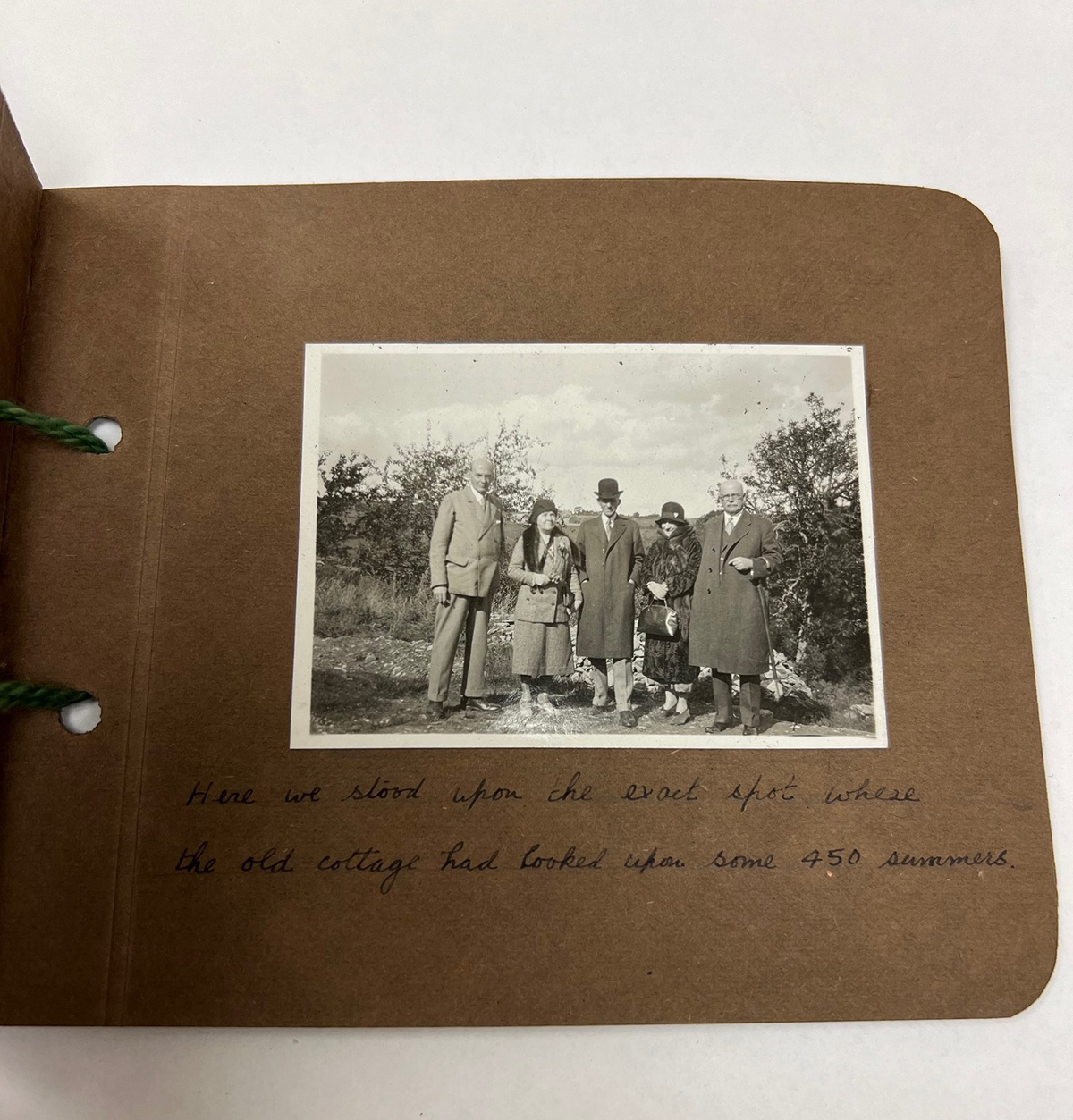
"The Cotswolds" Photograph Album, 1930. Accession 1, Box 106. / Image by Lauren Brady
Clara's diary entries with descriptions of cities and historic sites she encountered are valuable to historians looking for written records of landscapes altered by wars and other major events. Her words help us understand Clara Ford as a historical figure, but they also help us understand a location as it stood at that moment in time.
We are grateful to have these valuable archival records, but it is fun to wonder how a modern Clara may have documented her travels. Perhaps a post like this...
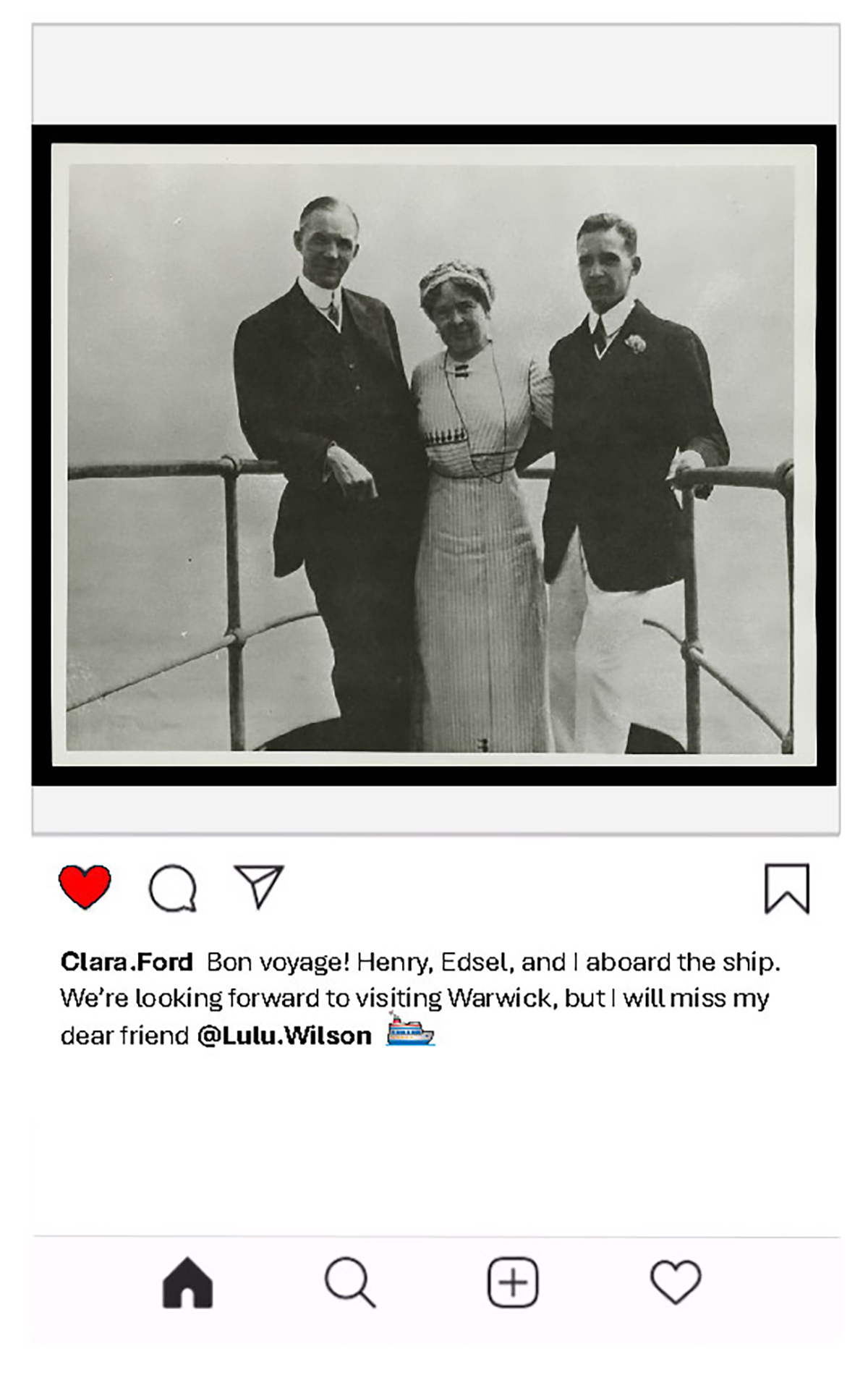
If you have any questions or would like to learn more about our collections, please contact the Benson Ford Research Center at research.center@thehenryford.org.
Lauren Brady is a reference archivist at The Henry Ford.
Edsel Ford, Ford family, Henry Ford, Clara Ford, by Lauren Brady
The Federal-Aid Highway Act of 1956
 "The Road Ahead, the Exciting Story of the Nation's 50 Billion Dollar Road Program," 1956 / THF103981
"The Road Ahead, the Exciting Story of the Nation's 50 Billion Dollar Road Program," 1956 / THF103981
Last June marked the 65th anniversary of the Federal-Aid Highway Act of 1956, which initiated a program to plan and fund an interstate system. In recognition of this milestone, Reference Archivist Lauren Brady selected some items from our collections that show how the highway system changed the American way of life. She shared these artifacts as part of our monthly History Outside the Box series on Instagram, which showcases items from our archives.
If you missed her presentation or would like to see it again, you can check it out below.
Continue Reading
20th century, 1950s, roads and road trips, History Outside the Box, by Lauren Brady, by Ellice Engdahl, archives
Rover: The Canine Keeper of Cotswold Cottage

Rover Keeping Watch outside Cotswold Barn, January 1931 / THF623050
When Cotswold Cottage and its surrounding buildings were brought to Greenfield Village, Henry Ford aimed to recreate every detail of one of his and Clara’s favorite regions of England.
Henry purchased the cottage, barn, and a nearby blacksmith shop for Greenfield Village in 1929 and the structures were shipped in 1930. Along with the disassembled structures came English stonemasons, who were tasked with reconstructing each building stone by stone. Henry promoted one of his own employees, Gus Munchow, to take charge of recreating the gardens and grounds around them.
Cotswold Cottage / THF1690
The earliest interpretation of Cotswold Cottage intended to present it as a home for English sheepherders. To fully bring this story to life, Henry had a group of sheep imported from the Cotswold region of England to take up residence on the grounds.
Cat Riding a Sheep at Cotswold Cottage, 1932 / THF134679
Plans for the Cotswold setting were nearly perfect, except for one very large missing detail.
When the English stonemasons recalled a black Newfoundland sheep dog roaming the original site, Henry inquired if the dog might consider a move to Michigan. The stonemasons suggested the dog “undoubtedly adored the King” and probably “did not like boats.” Instead, it was decided to find a substitute puppy that could be raised at the cottage to act as sheepherder and guardsman like his English predecessor.
Henry’s secretary began researching the best genetic strains of Newfoundland dogs and located a litter from a lineage of aristocratic, award-winning dogs nearby in Canada. Rover, deemed their best dog, was sent by train to Dearborn.
Rover at Cotswold Cottage, 1932 / THF134670
Rover was trained by Gus Munchow, manager of the gardens and grounds, and was given a home in the Cotswold barn—although some accounts recall he often made himself comfortable inside the cottage. Weighing more than 130 pounds by his first birthday, Rover quickly grew into a smart and dedicated companion to both the sheep and Gus.
Dedicated in all seasons, day and night, Rover happily attended to chores with Gus. He delivered feeding buckets to the sheep, carried extra tools, and was responsible for holding the clock on their night rounds. 
Rover outside Cotswold Barn with Gus Munchow and Sheep / THF623048
One of several canine citizens of Greenfield Village at the time, Rover’s neighbors included two Dalmatian coach dogs and a Scottish Terrier named McTavish that enjoyed the company of the schoolchildren who learned in the Giddings Family Home next door.
Enthusiastic in his pursuit to keep any of the other Village dogs from approaching the grounds he guarded, Rover had the stature and size to insist upon them keeping their distance—and they happily obeyed.
Rover at Cotswold Cottage, 1932 / THF134667

Rover with Edison Institute Schoolchildren, Featured in The Herald, April 5, 1935 / THF623054
Even Henry Ford was an admirer of Rover. Gus recalled in his oral history: “That dog would only take orders from myself and Mr. Ford. Mr. Ford used to come through that gate, and the dog would run up to him, and he would play with him for a minute or two.”
Henry realized Rover’s deep bond to Gus when his beloved master fell ill in July 1934. Gus had suffered from appendicitis and was rushed to Henry Ford Hospital, where he stayed for more than a week. When Henry came to visit Rover, he found him lying in the middle of the road, unwilling to move. He seemed to be waiting for Gus to return and was refusing to eat. Realizing Rover must be distressed by Gus’s absence, he requested the dog receive a special bath and be driven in his personal car to the hospital.
The scene of the giant dog visiting the hospital caught the attention of the Detroit News, which wrote a feature article on the visit: “There was a great deal of difficulty in getting the large dog into the hospital, and once inside the door, he had to be dragged along. But when he approached the room where Gus lay and heard the sound of his master’s voice, he ran joyfully to the bed, jumped upon it, and threw everybody and everything into confusion.” The article was happy to report that following the reunion, Rover quickly regained both his appetite and the 15 pounds he had lost from worry.
Feature photo from a Detroit News article found in Ford Motor Company Clipping Book, Volume 88, April–November 1934 / THF623060
When Gus returned to work, Rover always had one eye on his sheep and one eye on his master, making sure neither wandered too far out of sight.
Rover continued serving Gus and Cotswold Cottage for many years. He was indeed “a very good and faithful pal” whose spirit will live on forever as part of Greenfield Village. His grave marker can still be seen today behind the cottage.
Rover’s grave marker, located behind Cotswold Cottage / Photo by Lauren Brady
Lauren Brady is Reference Archivist at The Henry Ford.
Michigan, Dearborn, 20th century, 1930s, Henry Ford, Greenfield Village history, Greenfield Village buildings, Greenfield Village, farm animals, by Lauren Brady

